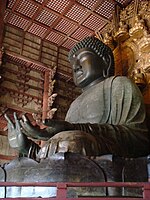Eight Legions
This article has multiple issues. Please help improve it or discuss these issues on the talk page. (Learn how and when to remove these messages)
|
| Translations of Eight Legions | |
|---|---|
| English | Eight Legions |
| Sanskrit | अष्टसेना Aṣṭasenā |
| Chinese | 八部眾; 天龍八部 (Pinyin: Bābùzhòng; Tiānlóngbābù) |
| Japanese | 八部衆; 天龍八部衆 (Rōmaji: Hachibushū; Tenryūhachibu) |
| Korean | 팔부신장; 천룡팔부 (RR: Palbusinjang; Cheonryongpalbu) |
| Tibetan | ལྷ་འདྲེ་སྡེ་བརྒྱད་ Wylie: lha srin sde brgyad |
| Tagalog | Astasena |
| Vietnamese | Bát Bộ Chúng; Thiên Long Bát Bộ |
| Glossary of Buddhism | |
The Eight Legions (Sanskrit: अष्टसेना, Aṣṭasenā; 八部衆) are a group of Buddhist deities whose function is to protect the Dharma. These beings are common among the audience addressed by the Buddha in Mahāyāna sūtras, making appearances in such scriptures as the Lotus Sutra and the Golden Light Sutra. They are also referred to as the "Eight Legions of Devas and Nāgas" (天龍八部).[1]
Asuras are also listed here as protectors of Dharma in the same sense as demigods are referred as "asuratvam" (holy) in Rigvedic "Hymn to all gods" where devas are related to "asuras" (thus, protectors of Dharma). Related word "ahura" in Zoroastrianism also means "god".
Etymology
The name aṣṭasenā (अष्टसेना) is composed of two Sanskrit terms.
Aṣṭa (अष्ट) means eight, with connections to the Latin octo and the Persian hašt (هشت). Senā (सेना) means legion, but can be rendered army, general, warrior and the like. Yet for the sake of accuracy contrary to the custom, each legion has a unique standard/banner and is composed just of several thousand foot soldiers. For that size of a military unit there is a fitting Sanskrit term "Dhvajinī", i.e. "body of troops bearing a standard". "Sena" is better to translate as "army" due to the fact that enormous Kuru and Pāṇḍava troops that gathered on the battlefield were called "kurupāṇḍava-sena" (one can't label two huge military forces fighting each other as just one legion), and more than that, all wars in India are patronized by the god of war Kārtikeya who probably plays both sides in any conflict if adversary combatants worship devas. His wife's name is Sena, a goddess, commonly known as Deva-Sena, the personified armament of the gods. There were plenty of legions in India serving various kings and lords, but all military forces as a whole could be figuratively named an army, i.e. "Sena" - the Shakti through which the god of war imposed his will.
Summary
The Eight Legions have their origins in ancient India as gods who belong to several domains. Many of these gods are among those spirits who are found in the lower heavens of Cāturmahārājakāyika and the Asura realm, and as such largely consist of nature spirits. While the list of figures within this category vary, the most common are as follows:
| Sanskrit | Chinese | Japanese | Korean | Vietnamese | Tagalog | Tibetan(Wly.) |
|---|---|---|---|---|---|---|
| Deva | 天眾 (pinyin: Tiānzhòng) |
天部 (tenbu) |
천중 (RR: cheonjung) |
Thiên, Thiên chúng | Deva | ལྷ lha |
| Nāga | 龍眾 (pinyin: Lóngzhòng) |
竜 (ryū) |
용 (RR: yong) |
Long, Long chúng | Naga | ཀླུ klu |
| Yakṣa | 夜叉 (pinyin: Yèchā) |
夜叉 (yasha) |
야차 (RR: yacha) |
Dạ Xoa | Yaksa | གནོད་སྦྱིན་ gnod sbyin |
| Gandharva | 乾闥婆 (pinyin: Gāntàpó) |
乾闥婆 (kendatsuba) |
간다르바 (RR: gandareuba) |
Càn Thát Bà | Gandhalba | དྲི་ཟ། dri za |
| Asura | 阿修羅 (pinyin: Āxiūluó) |
阿修羅 (ashura) |
아수라 (RR: asura) |
A Tu La | Asula | ལྷ་མ་ཡིན་ lha ma yin |
| Garuḍa | 迦樓羅 (pinyin: Jiālóuluó) |
迦楼羅 (karura) |
가루다 (RR: garuda) |
Ca Lâu La | Garuda | ཁྱུང Khyung |
| Kiṁnara | 緊那羅 (pinyin: Jǐnnàluó) |
緊那羅 (kinnara) |
긴나라 (RR: ginnara) |
Khẩn Na La | Kinnara | མིའམ་ཅི། mi'am ci |
| Mahoraga | 摩睺羅伽 (pinyin: Móhóuluójiā) |
摩睺羅伽 (magoraga) |
마후라가 (RR: mahuraga) |
Ma Hầu La Già | Maholaga | ལྟོ་འཕྱེ་ཆེན་པོ་ lto 'phye chen po |
Variations
At Kōfuku-ji in Nara, Japan, there is a famous group of statues that represent the Eight Legions. Some of these figures differ from the common list. Their names in Japanese are as follows:
- Gobujō (五部浄, Śuddhāvāsa , a deva and personification of the heaven of the fourth dhyāna. There are five gods who reside here, all anāgāmins: Īśvara, Samantakusuma, Raśmimālin, Manojava, and Svaraviśruti.)[2]
- Sagara (沙羯羅, Sāgara, the Nāga King)
- Kubanda (鳩槃荼, Kumbhāṇḍa)
- Kendatsuba (乾闥婆, Gandharva)
- Ashura (阿修羅, Asura)
- Karura (迦楼羅, Garuḍa)
- Kinnara (緊那羅, Kiṁnara)
- Hibakara (畢婆迦羅, Mahoraga)
There is another list of eight beings, the Hachibukikishū (Japanese; 八部鬼衆), who belong to an overlapping, but distinct category.
In Popular culture
The Chinese title of Jin Yong's novel Demi-Gods and Semi-Devils is a reference to the Eight Legions. His original plan was to map each major character to one race, but this proved impossible as the novel progressed.
See also
References
- ^ "hachibushuu 八部衆". JAANUS. 2001. Retrieved 14 April 2019.
- ^ Giebel, Rolf W. (2005). "The Vairocanābhisaṃbodhi Sūtra" (PDF). Bukkyo Dendo Kyokai. Bukkyō Dendō Kyōkai and Numata Center for Buddhist Translation and Research. Retrieved 14 April 2019.


